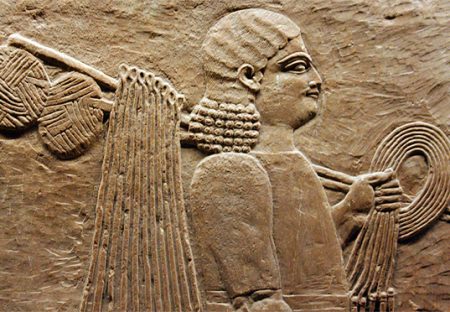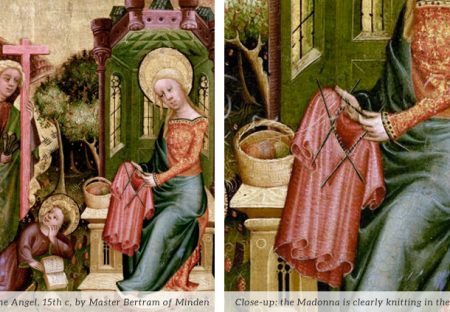 To celebrate the newly launched Headband Duo knitting pattern on Skillshare, let’s uncover the weird and wonderful history of the headband. Its story is so vast and interesting that I ended up splitting the post into two parts. Check out Part 2 once you’re ready!
To celebrate the newly launched Headband Duo knitting pattern on Skillshare, let’s uncover the weird and wonderful history of the headband. Its story is so vast and interesting that I ended up splitting the post into two parts. Check out Part 2 once you’re ready!
Headbands have taken many shapes and forms over the ages. From the laurel wreaths of Ancient Greece to the feathered headbands of the Roaring Twenties to the sporty sweatbands that became an athletic staple in the 70s (and persist to this day, cough LeBron James cough), the headband has endured for over two centuries, and it’s shape and function have evolved right along with us.
Wreaths in Ancient Greece

The earliest examples of headbands are probably the laurel wreaths in Ancient Greece. These were rewarded to victors in athletic competitions, like the Olympics, and to winners of poetry competitions. Eventually, the laurel wreath became a symbol of accomplishment and distinction (think modern day Poet Laureates, Noble Laureates, and baccalaureates).

While laurel wreaths were almost exclusively worn by men in Ancient Greece, wealthy or high-ranking women wore diadems. Crafted in gold, these are examples of the incredible refinement of Greek jewellry-making.
Turbans: A Touch of the Orient
From here we fast-forward to the early 20th century where Paris was in the throes of a love affair with jazz and fantasies of the Orient. During this period, two titans of fashion, Coco Chanel and Paul Poiret, shaped the look of the “New Girl.”

Both Chanel and Poiret renounced the fussy corsets of the previous century in favour of a looser, relaxed fit. They both drew inspiration from the the mystique of the Orient and incorporated beading, feathers and sequins into their designs as well as lush velvet and deep, rich colors.
Much of their inspiration came from Les Ballet Russes, a travelling ballet company based in Paris that managed to recruit some of the greatest artists of the early twentieth century day: Igor Stravinsky, Pablo Picasso, and Henri Matisse among many others!

Paul Poiret’s turbans and others like it were playful, mysterious, and tinged with the exotic – a perfect look for the modern and newly emancipated women of the 20s.
A turban signalled glamour, worldliness and a touch of mystery. By the 1920s it was a staple in eveningwear and worn by starlets of the day.

From Medical Aid to Fashion Statement
In the early 20th century a curious medical aid called the headache band emerged. Wrapped tightly around the head it acted as a compress to relieve headaches.

From its medical function the headache band grew into a stylish accessory during the Roaring Twenties. Like turbans, they were jewelled, sequinned, feathered and latticed to invoke Eastern mystique. Headbands became integral to a flapper’s look. Fanciful and decorative, they were also useful for keeping the flapper’s hair in place while she danced the Charleston!


Even Coco Chanel was a fan of the headband. She poses here with Serge Lifar, one of the greatest male ballet dancers of the 20th century. Quite the power couple!

French tennis player Suzanne Lenglen was winner of 31 Championship titles. She was the first female tennis celebrity, nicknamed La Divine by the French press. Her flamboyant and glamorous style coupled with her agility and grace drew sold-out matches and increased women’s interest in tennis and sports. She frequently wore a headband in a nod to flapper style during her matches.

WOWs and Headscarves in WWII
The headband of the 1940s evolved into something very different from its bejewelled predecessor. During World War II, headbands transformed from decorative to utilitarian.
The US entered WWII in 1941, and while men were drafted to the trenches, women were left at home to support the war effort. For many women this meant leaving their domestic duties to join the workforce.


From 1940 to 1945, the number of female workers increased from 27% to nearly 37%. Half of these women took on tough jobs in defence industries.
Women who worked in ordnance plants making weapons and ammunitions were called WOWs (short for Women Ordnance Workers). WOWs identified themselves by wearing red scarves around their heads. More than accessories, these headscarves, wrapped like turbans, protected women’s hair from heavy machinery while they worked.

Although some illustrations show the WOW scarves as polka dotted, the actual scarves were less benign. They were printed with exploding cannons, part of the logo for the US Ordnance Department.

In 1942, artist J. Howard Miller was hired by the Westinghouse Company’s War Production Coordinating Committee to create a series of posters to support the war effort. He produced the now-famous “We Can Do It!” poster depicting a strong woman in a headscarf flexing her bicep.

The poster was only showed to Westinghouse employees for a two-week period in 1943 to boost morale. Then it was taken down and put into storage for nearly four decades.
It would have languished in obscurity if it hadn’t been for the feminist movement of the 1980s when it was unearthed and brandished as a symbol of female empowerment.
Since the 80s, the woman in the poster, nicknamed Rosie the Riveter, has become an icon of strong, independent women united against the patriarchy – a very different image from the flapper with her jewelled headband!
There’s more history of the headband in Part 2, including the headband as worn by 60s sex kitten Brigitte Bardot, flower power hippies, a serious French intellectual and NBA star LeBron James. Coming soon!




I really like the turbans from the 20s! Is it possible to knit a turban?
Hey Jillian! I’m sure it’s possible to knit a turban! A turban is like a knitted hat, but with a cinched-in band. Totally possible!
Great Article. I love making turbans by myself. You can add so much details and creations to that gorgeous headpiece.
craftasy.etsy.com
Great article! That’s Greta Garbo and not Joan Crawford though. Other than that, fantastic!
Oops! You’re right! Will go ahead and fix that 😛
Ouch!
Bought these for my wife, who has really enjoyed them! She’s not a fan of hats but wants something to keep her hair out of the way. An amazing deal to get ten bands for the same price as three for other bands. And honestly I believe these are higher quality than most. A steal of a deal!